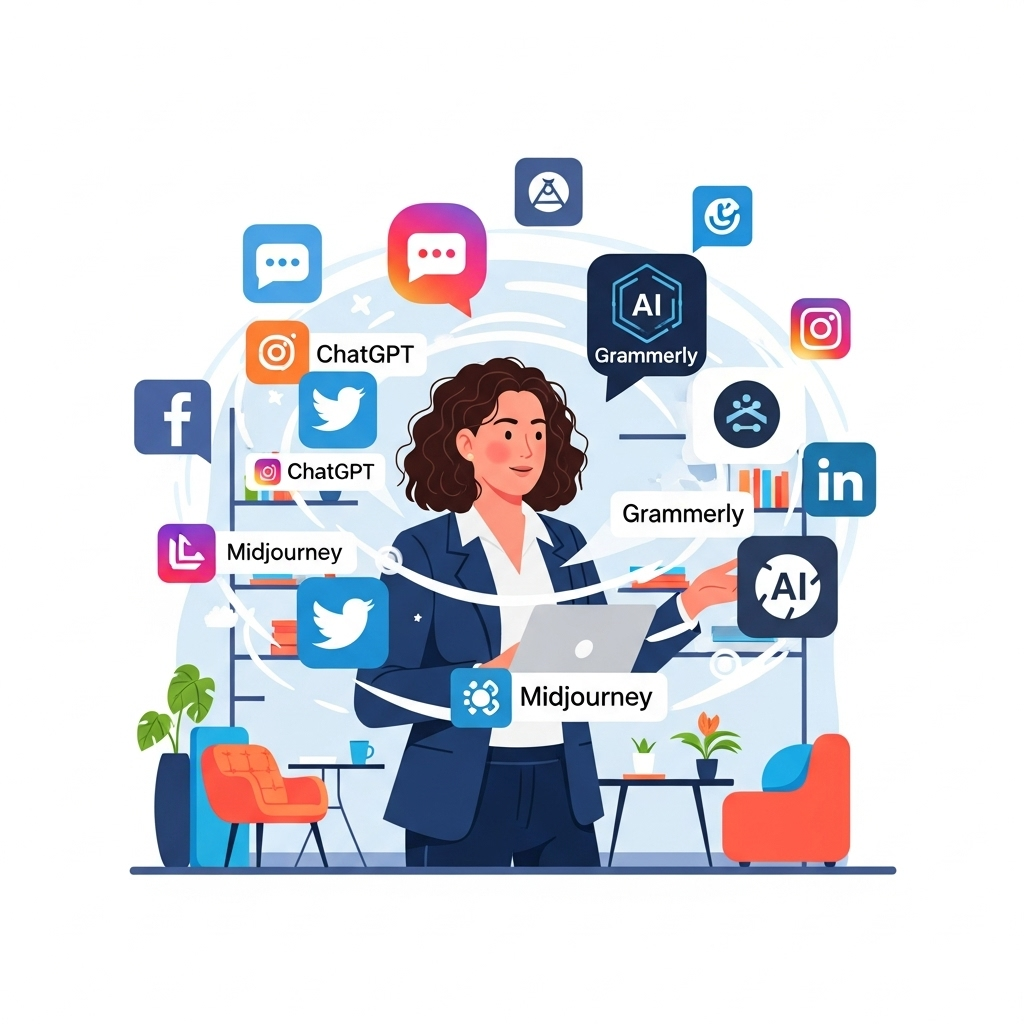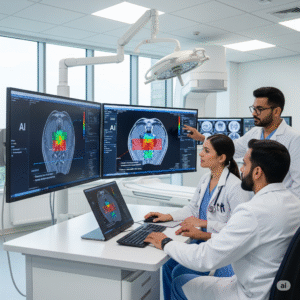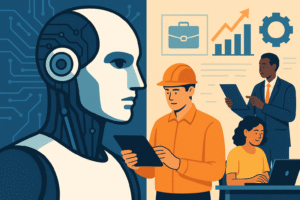Introduction to AI in Professions
Artificial Intelligence (AI) is no longer a futuristic concept—it’s actively reshaping how we work across industries. From automating repetitive tasks to providing data-driven insights, AI in professions is revolutionizing workflows, saving time, and unlocking new opportunities for professionals. Whether you’re a marketer, educator, or healthcare worker, understanding how AI in professions can enhance your role is essential to staying competitive in today’s fast-paced world.
In this 1500+ word guide, we’ll explore the top 5 professions being transformed by AI, diving into real-world use cases, practical tools, and actionable tips to help you leverage AI in professions for maximum impact. We’ll also include case studies and credible references to show how AI is making a tangible difference. Let’s dive in!
Why AI in Professions Matters
AI is transforming workplaces by automating mundane tasks, enhancing decision-making, and personalizing experiences. According to a McKinsey report, AI could automate up to 30% of current jobs by 2030, but it’s also creating new roles and opportunities. For professionals, adopting AI in professions means:
- Time Savings: Automating repetitive tasks frees up hours for strategic work.
- Enhanced Accuracy: AI reduces human error in data analysis and predictions.
- Scalability: AI tools handle large volumes of work effortlessly.
- Accessibility: Many AI tools are beginner-friendly, requiring no coding skills.
Let’s explore the top five professions where AI in professions is making the biggest impact.
1. Marketing: Personalization and Automation
How AI Transforms Marketing
Marketers are using AI in professions to create targeted campaigns, analyze consumer behavior, and automate content creation. AI tools like HubSpot’s AI-powered CRM predict customer needs, while platforms like Jasper.ai generate blog posts and ad copy in minutes.
Use Cases
- Content Creation: AI tools draft social media posts, emails, and blogs, saving hours of writing time.
- Audience Segmentation: AI analyzes customer data to create personalized marketing campaigns.
- Ad Optimization: Platforms like Google Ads use AI to optimize bids and target audiences, improving ROI.
Real-World Example
A small e-commerce brand used Mailchimp’s AI features to personalize email campaigns. By analyzing customer purchase history, the AI sent tailored product recommendations, boosting click-through rates by 20% and saving the team 10 hours a week on manual segmentation.
Tools for Marketers
- Jasper.ai: Generates marketing copy quickly.
- HubSpot: Automates lead scoring and email workflows.
- Canva AI: Creates visually appealing graphics with AI suggestions.
Practical Tip
Start with a free trial of Jasper.ai to draft a week’s worth of social media posts in under an hour. Use the time saved to focus on strategy and creative brainstorming.
2. Healthcare: Diagnostics and Patient Care
How AI Transforms Healthcare
In healthcare, AI in professions is revolutionizing diagnostics, patient care, and administrative tasks. AI algorithms analyze medical images, predict patient outcomes, and streamline hospital operations. According to a Stanford Medicine study, AI can match or outperform human doctors in certain diagnostic tasks.
Use Cases
- Medical Imaging: AI tools like IBM Watson Health detect abnormalities in X-rays and MRIs.
- Predictive Analytics: AI predicts patient readmissions, helping hospitals allocate resources.
- Virtual Health Assistants: AI chatbots schedule appointments and answer patient queries.
Case Study: Dr. Lisa’s Radiology Practice
Dr. Lisa, a radiologist, integrated Aidoc’s AI platform to analyze CT scans. The AI flagged critical cases in seconds, reducing her review time by 15 hours a week and improving patient outcomes by prioritizing urgent cases.
Tools for Healthcare Professionals
- IBM Watson Health: Analyzes medical data for diagnostics.
- Ada Health: AI-powered symptom checker for patients.
- Zebra Medical Vision: Detects diseases in medical imaging.
Practical Tip
Explore free AI tools like Ada Health to assist with preliminary patient assessments, saving time on routine consultations.
3. Education: Personalized Learning and Grading
How AI Transforms Education
Educators are leveraging AI in professions to personalize learning, automate grading, and enhance student engagement. Tools like Google’s Teachable Machine allow teachers to create custom AI models, while platforms like Gradescope streamline grading.
Use Cases
- Personalized Learning: AI adapts lesson plans to individual student needs.
- Automated Grading: AI grades assignments and provides feedback instantly.
- Student Engagement: AI chatbots answer student questions 24/7.
Real-World Example
A high school in California used Gradescope to grade math assignments. The AI reduced grading time from 12 hours to 3 hours per week, allowing teachers to focus on student support and curriculum development.
Tools for Educators
- Gradescope: Automates grading for exams and assignments.
- Quizlet AI: Generates personalized study materials.
- Socrative: Uses AI to create interactive quizzes.
Practical Tip
Use Quizlet’s AI to create flashcards tailored to your students’ learning levels, saving hours on lesson prep.
4. Human Resources: Streamlined Recruitment
How AI Transforms HR
HR professionals are using AI in professions to automate resume screening, predict candidate fit, and enhance employee engagement. Tools like Workable use AI to match candidates to job requirements, reducing hiring time.
Use Cases
- Resume Screening: AI filters resumes based on skills and experience.
- Candidate Sourcing: AI identifies top talent from platforms like LinkedIn.
- Employee Insights: AI analyzes employee feedback to improve workplace culture.
Case Study: Tech Startup’s Hiring Process
A tech startup implemented Workable’s AI recruiting tool to screen 500+ resumes for a developer role. The AI shortlisted top candidates in hours, saving the HR team 20 hours of manual review and ensuring a better candidate fit.
Tools for HR Professionals
- Workable: Automates candidate sourcing and screening.
- Textio: Enhances job descriptions with AI for inclusivity.
- Grok: Answers HR queries and provides workflow suggestions.
Practical Tip
Try Workable’s free trial to automate resume screening for your next hire, cutting down on manual review time.
5. Content Creation: Scaling Creativity
How AI Transforms Content Creation
Freelancers, YouTubers, and bloggers are using AI in professions to scale content production and enhance creativity. Tools like Descript automate video editing, while AI platforms like DALL·E generate unique visuals.
Use Cases
- Video Editing: AI removes filler words and edits videos automatically.
- Content Generation: AI writes scripts, blog posts, or captions.
- Visual Design: AI creates images or graphics for social media.
Real-World Example
A YouTuber used Descript to edit a 20-minute video. The AI removed filler words and synced audio in 30 minutes, compared to 5 hours manually, allowing her to produce content faster and grow her channel.
Tools for Content Creators
- Descript: Automates video and podcast editing.
- DALL·E: Generates unique images from text prompts.
- Copy.ai: Creates blog posts and social media content.
Practical Tip
Use Descript’s free version to edit a podcast episode, saving hours on manual audio cleanup.
Challenges and Ethical Considerations of AI in Professions
While AI in professions offers immense benefits, it comes with challenges:
- Bias: AI can perpetuate biases in hiring or diagnostics if trained on flawed data.
- Privacy: AI tools handling personal data must comply with regulations like GDPR.
- Job Displacement: Automation may reduce demand for certain roles, requiring reskilling.
To address these, choose transparent AI tools and stay informed about ethical guidelines, such as those outlined by OpenAI.
How to Get Started with AI in Your Profession
Ready to embrace AI in professions? Follow these steps:
- Identify Pain Points: Pinpoint tasks that take up time, like grading or content creation.
- Choose Beginner-Friendly Tools: Start with free or low-cost tools like ChatGPT or Zapier.
- Experiment and Learn: Test AI tools on small projects to understand their impact.
- Join Communities: Engage with AI enthusiasts on X or LinkedIn for tips and updates.
- Stay Updated: Follow blogs like Zapier’s AI section for the latest tools and trends.
The Future of AI in Professions
The future of AI in professions is bright, with trends like:
- No-Code AI: Platforms like Bubble make AI accessible to non-coders.
- Personalized AI Assistants: Tools like Grok will tailor solutions to your role.
- Ethical AI: Increased focus on reducing bias and ensuring transparency.
By adopting AI in professions now, you’ll be prepared for these advancements and stay ahead in your field.
Conclusion
AI in professions is transforming how we work, from marketing to healthcare, education, HR, and content creation. By automating repetitive tasks, providing insights, and scaling creativity, AI saves professionals hours each week while enhancing outcomes. Start exploring tools like Jasper.ai, Gradescope, or Workable to see immediate time savings and productivity boosts.
Embrace AI in professions today to work smarter, not harder, and unlock new possibilities in your career!
AI in professions, AI tools for professionals, AI in marketing, AI in healthcare, AI for educators, AI in HR, AI for content creators, save time with AI, AI productivity tools
14 Artificial Intelligence Careers & Job Outlook [2025]
16 Artificial Intelligence Career Paths
Save Time with AI (10+ Hours a Week)



